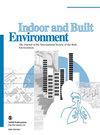A simulation-based investigation of the robustness of sequences of operation to zone-level faults in single-duct multi-zone variable air volume air handling unit systems
IF 2.9
3区 工程技术
Q2 CONSTRUCTION & BUILDING TECHNOLOGY
引用次数: 0
Abstract
High-performance sequences of operation for variable air volume (VAV) air handling units (AHUs) respond to requests from zones, leaving these sequences vulnerable to faults that occur at the zone level. While prior research has shown that ASHRAE Guideline 36 reduces energy consumption, its ability to withstand zone-level faults is understudied. This paper investigates the fault tolerance of supply air temperature (SAT) setpoint, duct static pressure (DSP) setpoint and mode of operation (MOP) in single-duct multi-zone VAV AHUs. First, customized sequences were defined for different scenarios in EnergyPlus in this study. Then, common actuator/sensor faults were injected into one zone to identify the most efficient fault-tolerant scenario. The results indicate that trim and respond reset logic is the most fault-tolerant scenario for this paper’s case study, with a 12% energy use intensity (EUI) increase for the SAT setpoint and an 11% increase for the DSP setpoint. Moreover, implementing an average temperature–based control for MOP significantly reduces the setup/setback mode activation, resulting in a lower EUI.基于模拟的单管多区变风量空气处理机组系统运行序列对区级故障的稳健性研究
变风量(VAV)空气处理机组(AHU)的高性能运行顺序响应分区的要求,因此这些顺序很容易受到分区级故障的影响。此前的研究表明,ASHRAE 准则 36 可降低能耗,但对其抵御区域级故障的能力研究不足。本文研究了单风道多分区 VAV 自动空调机组的送风温度(SAT)设定点、管道静压(DSP)设定点和运行模式(MOP)的容错能力。在本研究中,首先在 EnergyPlus 中为不同场景定义了定制序列。然后,将常见的执行器/传感器故障注入一个区域,以确定最有效的容错方案。结果表明,在本文的案例研究中,微调和响应复位逻辑是容错能力最强的方案,SAT 设定点的能源使用强度(EUI)增加了 12%,DSP 设定点增加了 11%。此外,基于平均温度的澳门威尼斯人官网业控制大大减少了设置/复位模式的启动,从而降低了 EUI。
本文章由计算机程序翻译,如有差异,请以英文原文为准。
求助全文
约1分钟内获得全文
求助全文
来源期刊

Indoor and Built Environment
环境科学-工程:环境
CiteScore
6.40
自引率
25.00%
发文量
130
审稿时长
2.6 months
期刊介绍:
Indoor and Built Environment publishes reports on any topic pertaining to the quality of the indoor and built environment, and how these might effect the health, performance, efficiency and comfort of persons living or working there. Topics range from urban infrastructure, design of buildings, and materials used to laboratory studies including building airflow simulations and health effects. This journal is a member of the Committee on Publication Ethics (COPE).
 求助内容:
求助内容: 应助结果提醒方式:
应助结果提醒方式:


